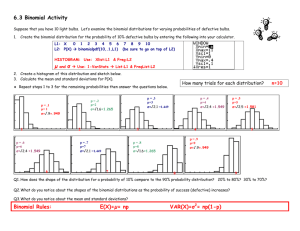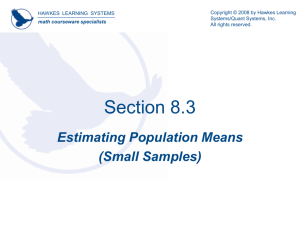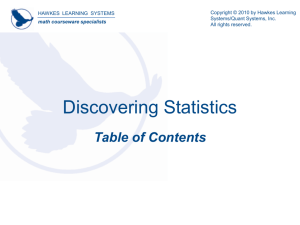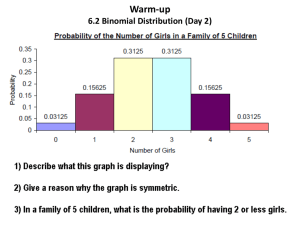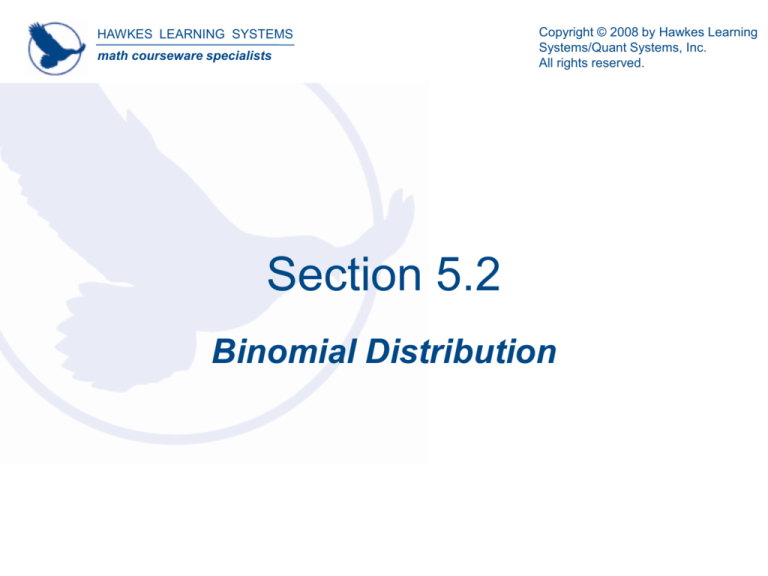
HAWKES LEARNING SYSTEMS
math courseware specialists
Copyright © 2008 by Hawkes Learning
Systems/Quant Systems, Inc.
All rights reserved.
Section 5.2
Binomial Distribution
HAWKES LEARNING SYSTEMS
Probability Distribution
math courseware specialists
5.2 Binomial Distribution
Definitions:
• Binomial distribution – a special discrete
probability function for problems with a fixed
number of trials, where each trial has only two
possible outcomes, and one of these outcomes is
counted.
x = the number of successes
n = the number of trials
p = the probability of getting a success on any trial
• Success – the outcome that is counted.
When calculating the binomial distribution, round your answers
to three decimal places.
HAWKES LEARNING SYSTEMS
Probability Distribution
math courseware specialists
5.2 Binomial Distribution
Binomial Distribution Guidelines:
1. The experiment consists of a fixed number of
identical trials, n.
2. Each trial is independent of the others.
3. For each trial, there are only two possible
outcomes. For counting purposes, one outcome is
labeled a success, the other a failure.
4. For every trial, the probability of getting a success
is called p. The probability of getting a failure is
then 1 – p.
5. The binomial random variable, X, is the number of
successes in n trials.
HAWKES LEARNING SYSTEMS
Probability Distribution
math courseware specialists
5.2 Binomial Distribution
Determine the probability:
What is the probability of getting exactly 7 tails
in 18 coin tosses?
Solution:
n = 18, p = 0.5, x = 7
HAWKES LEARNING SYSTEMS
Probability Distribution
math courseware specialists
5.2 Binomial Distribution
TI-84 Plus Instructions:
1. Press 2nd, then VARS
2. Choose 0: binompdf(
3. The format for entering the statistics is
binompdf(n,p,x)
In the previous example we could have entered
binompdf(18,0.5,7).
HAWKES LEARNING SYSTEMS
Probability Distribution
math courseware specialists
5.2 Binomial Distribution
Determine the probability:
A quality control expert at a large factory estimates
that 10% of all batteries produced are defective. If a
sample of 20 batteries are taken, what is the
probability that no more than 3 are defective?
Solution:
n = 20, p = 0.1, x = 3, but this time we need to look at
the probability that no more than three are
defective, which is P(X ≤ 3).
P(X ≤ 3) = P(X = 0) + P(X = 1) + P(X = 2) + P(X = 3)
= 20C0(0.1)0(0.9)20 + 20C1(0.1)1(0.9)19 +
20C2(0.1)
0.867
2(0.9)18
+ 20C3(0.1)3(0.9)17
HAWKES LEARNING SYSTEMS
Probability Distribution
math courseware specialists
5.2 Binomial Distribution
TI-84 Plus Instructions:
1. Press 2nd, then VARS
2. Choose A: binomcdf(
3. The format for entering the statistics is
binomcdf(n,p,x)
In the previous example we could have entered
binomcdf(20,0.1,3).
HAWKES LEARNING SYSTEMS
Probability Distribution
math courseware specialists
5.2 Binomial Distribution
Determine the probability:
A quality control expert at a large factory estimates
that 20% of all batteries produced are defective. If a
sample of 10 batteries are taken, what is the
probability that more than 1 are defective?
Solution:
n = 10, p = 0.2, x = 1, but this time we need to look at
the probability that more than one are defective,
which is P(X > 1).
P(X > 1) = 1 - P(X ≤ 1)
= 1 - 10C0(0.2)0(0.8)10 + 10C1(0.2)1(0.8) 9
0.624


